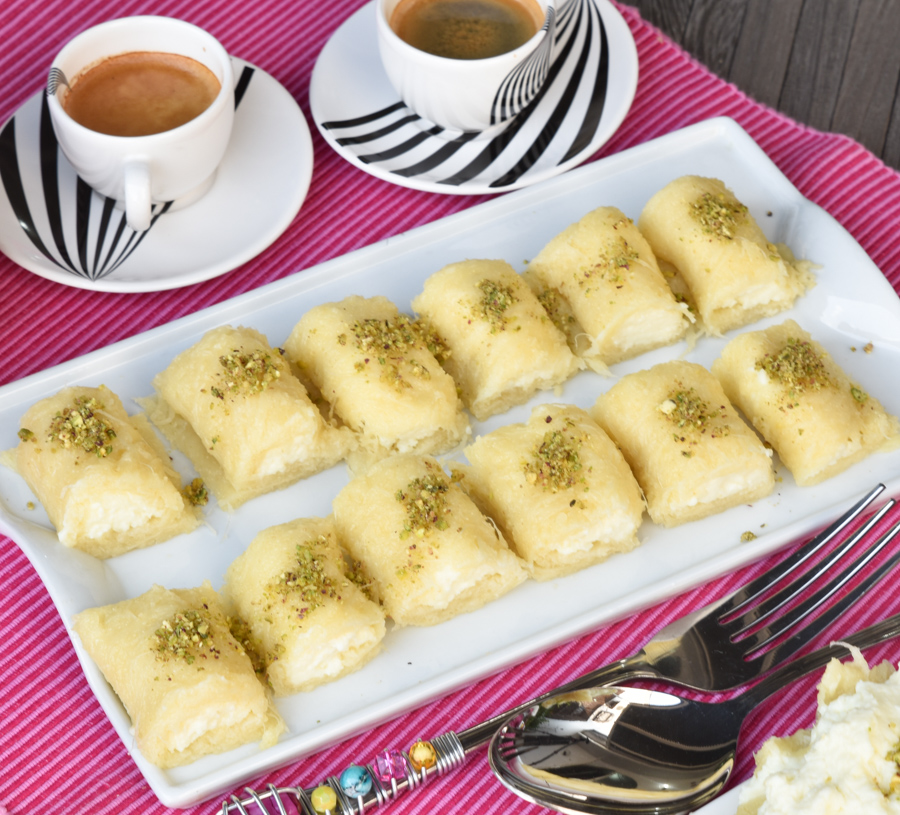
Halawet Al Jibn

Halawet El Jibn (Sweet Semolina-Cheese Rolls) حلاوة الجبن
Halawet El Jibn! One of the most common requests I receive in my inbox is from readers asking me to post a recipe for “Halawet El Jibn”. The dessert is a well-loved classic for a reason. A dense stretchy cheese-semolina dough that envelopes a milky clotted cream like filling —that we call in Arabic ashta —and drizzled with sugar syrup flavored with orange blossom water. A unique Lebanese and Syrian dessert that reflects the pure refined art of our cuisine in terms of presentation and taste. Yes, a genius culinary technique that Lebanese and Syrian chefs perfected with precision over years —”Halawet El Jibn” is elegant, sophisticated, and an utterly gourmet dessert.

The origin of Halawet El Jibn! Oriental sweet shops all across Lebanon and Syria have “Halawet El Jibn” on the menu, and now these sweet semolina-cheesy rolls with their creamy soft center are on the rise and are gaining popularity in other parts of the world too. “Halawet El Jibn” has survived the passage of time but was subject to evolution. Based on some videos I watched on YouTube, “Halawet El Jibn”, at the start, was a sweet semolina-cheese dough cut into strips and sold plain with sugar syrup. It is believed that the bright invention came from Asaad Salloura’s great-grandfather in the 1870s. It was sold on the streets of Hama carried over the head as a modest on the go dessert. Later it was improved and transformed to a more refined dessert filled with ashta(Middle Eastern clotted cream). This is one version of the story, others would blindly claim that the origin comes from the city of Homs in Syria; paradoxically, the debate doesn’t stop here since the city of Tripoli in Northern Lebanon, is home to the best “Halawet El Jibn”, some folks would strictly insist that the origin is Lebanese; brief, I found that it’s actually rooted in a variety of cities and countries. It is a non-stop war of words due to that strong sense of pride for one’s own national cuisine. Respect to the pastry chefs who honed the technique and continued the legacy by preserving one of the most iconic sweets of the Middle East, no matter what country or city of origin the bright invention came from — the inheritance of knowledge is important to sustain our food culture.
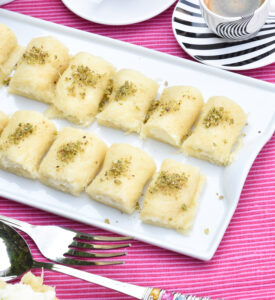
Tips and Tricks:
- This sublime dessert gets its deep Middle Eastern flavors and aromas from a combination of mastic gum and orange blossom water, lending it a lovely hint of agreeable floral undertone, so please don’t skip them.
- Not all cheeses are created equal when it comes to melting. Opt for cheeses that have good melting properties such as Tchiki Akkawi, majdoola or mozzarella, but still mozzarella is great for stretchiness. These types of cheeses have higher fat content and lower moisture, which makes them melt smoothly and infuse with sugar and semolina. Akawi cheese is a type of Middle Eastern cheese that is commonly used in a wide variety of sweet and savory dishes. It is heavily salted and need to be soaked to get rid of its saltiness, the best substitute would be mozzarella cheese that I tested and ended up finding so satisfying; but please use the best mozzarella you can find since the quality of the cheese will define the final result of your “Halawet El Jibn”.
- If you are using Tchiki Akkawi or majdoola cheese then you need to desalt since those cheeses are loaded with salt for preservation. Cut the cheese into squares, cover with water and soak it for 8 hours, changing the water every 1 hour to reduce its saltiness. Skip this step if you are using mozzarella!
- Grind 2 tablespoons of pistachios in your food processor, or use a spice or coffee grinder to process them to a fine powder, use them to garnish “Halawet Al Jibn”,
- Storage: Refrigerate Halawet El Jiben for up to 4 days, covered with plastic wrap to prevent from unwanted drying and to prolong its freshness.
A time saving strategy: While “Halawet El Jiben” looks laborious to make in terms of preparation, it is a fun project, and wait until you taste the flavors. For a time saving strategy, you can split the work in two stages. Stage 1: prepare the ashta( filling) and sugar syrup (atter) one day before. and keep in the refrigerator. Stage 2: make the semolina-cheeese dough the day you need to serve!
And now let’s get started!

To make the filling /ashta /(Middle Estern clotted cream): Place the milk, heavy cream, cornstarch and mastic in a saucepan over medium heat, whisking constantly until the mixture boils and thickens. Set aside, cover with a piece of parchment paper to prevent a skin from forming on top. Leave to cool down completely. This can be made one day ahead, kept in the refrigerator, to save time.
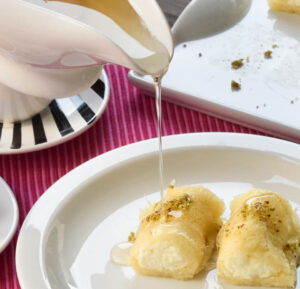
To make the sugar syrup (atter): Place the sugar, water, and lemon juice in a saucepan over medium heat. Stir the mixture with a wooden spoon to dissolve the sugar. Once it boils reduce heat to low and simmer for 7 minutes. Do not cover the saucepan. Add the orange blossom water and simmer for 1 more minute. Set aside to completely cool down
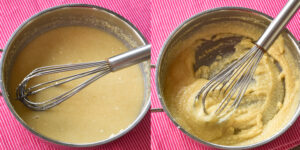
To make the semolina-cheeese dough: Add 3/4 cup sugar, 1/4 cup semolina, 3/4 cup fine semolina, crushed mastic and 1 1/4 cups water to a medium sauce pan and whisk them together over medium-high heat, whisking constantly until the mixture totally thickens. It happens fast! about 2 minutes
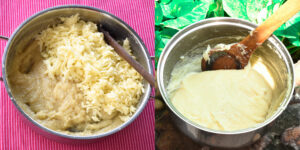
Reduce heat to low, add the shredded mozzarella cheese stir vigorously with a wooden spoon or spatula until the cheese is incorporated (whisk constantly so you end up with a uniform dough). Remove it from heat and keep it aside just until the dough is cool enough to handle. Divide it to two equal balls.
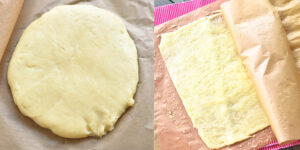
Work with one of the halves: Place two equal-sized sheets of parchment paper underneath and above the dough, making a kind of dough sandwich. Then roll out with your rolling pin, keeping the dough sandwiched between the two parchment sheets. Roll the dough as evenly as you can to create a rectangle shape and about 1 1/4 cm/ 1/2 inch thick, avoid thinning it or the dough will poke. Remove the top piece of parchment (if you have not already done so)
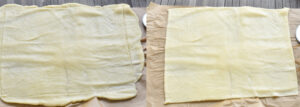
Use a ruler for this step. Cut the dough to a uniform rectangle, the dough doesn’t have to be a truly perfect rectangle. Trim the excess dough and set aside. (It would be a crime to throw away those trimmed pieces, eat them later with some ashta and sugar syrup!).

Using a pastry bag with a large coupler, apply a firm pressure and pipe a line of the filling close to the edge of the dough lengthwise. Starting at the end closest to you, carefully lift up the edge of the parchment to bring the innermost edge of the semolina-cheese dough up over the filling, using the parchment to encourage the roll to take on a circular shape until the filling(ashta) is totally sealed and the seam sides down. Then delicately, with a pizza cutter or sharp knife slice off the log from the rest of the dough.
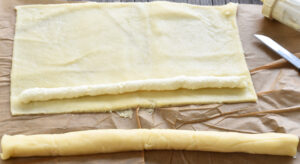
Pipe the filling in the same manner with the remaining part of the semolina-cheese dough, repeat with the second half dough. After using the two doughs, I ended up with 6 filled logs.

Using a sharp knife cut into equal mini morsels about 4-5 cm/ 1.5 inches long.

Transfer to a pretty platter, garnish each morsel with crushed pistachios, and if you are lucky enough to have jam rose petals, add them for a more attracting garnish; unfortuantely, I couldn’t find them where I live, no worries if you can’t too, they are just to add color. Serve with sugar syrup on the side.
The creamy center contrasts deliciously with the soft and stretchy cheesy semolina dough, this is a “must” at our house during the holy month of Ramadan or any family gathering —they are so rewarding,

Looking for more sugar syrup based recipes, we have you covered:
- Halawet Al Riz / Sweet Cheesy Rice Pudding
- Awamat (Lebanese Doughnuts)
- Knafeh Bil Ashta
- Ashtalieh/ Ashtalleya with Desiccated Coconut
- Bread Knafeh
- Nabulsi Knafeh/Kunafa,/ Knafeh Nabulsieh
- Znoud El Sit
“Halawet El Jibn” is an impressive-looking celebration dessert that is easier to make than you might suspect, even with all the steps you need to pace. Treat yourself to these sweet bites. I have been fixing “Halawet Al Jibn” for so long; writing the post, my mind travelled to those memories of eating it at sweet shops in Lebanon, how mom prepared and served it and how the recipe was transmitted to all family members and friends. Food, like culture itself, is a living thing; people live and relate to it. Whether you are hosting a party, or needed some extra cheering up “Halawet Al Jiben” is the perfect answer when you want a bit of comfort.
1 cup is 250 ml
- Author: Hadia Zebib Khanafer
- Cook: 30 minutes, makinh ashta, sugar syrup and sweet semolina dough
- Serves 7 persons
- Cuisine: Lebanese, Syrian

Ingredients:
To make the Lebanese clotted Cream (Ashta):
- 1 1/2 cups milk
- 1/2 cup heavy cream
- 2 heaped tablespoons cornstarch
- 1/4 teaspoon mastic gum, crushed with a pinch of sugar using a mortar and pestle
To make the sugar syrup, (atter):
- 2 cups sugar
- 1 cup water
- 2 tablespoons lemon juice
- 1 tablespoon orange blossom water
The semolina-cheese dough:
- 350 grams /12 oz mozzarella cheese
- 3/4 cup fine semolina, called in Arabic theen farkha
- 1/4 cup semolina
- 3/4 cup granulated sugar
- 1 1/4 cups water
- 1/4 teaspoon mastic gum, crushed with a pinch of sugar
- 2 tablespoons of shelled pistachios, for garnish
Directions:
- To make the ashta (Middle Estern clotted cream): Place the milk, heavy cream, cornstarch and mastic in a saucepan over medium heat, whisking constantly to avoid scorching. Once the liquid comes to a boil, the mixture will begin to work its thickening magic. (It should totally thicken). Set aside, cover with a piece of parchment paper to prevent a skin from forming on top. Leave to cool down completely.
- To make the sugar syrup (atter):Place the sugar, water, and lemon juice in a saucepan over medium heat. Stir the mixture with a wooden spoon to dissolve the sugar. Once it boils reduce heat to low and simmer for 7 minutes. Do not cover the saucepan. Add the orange blossom water and simmer for 1 more minute. Set aside to completely cool down.
- To Make the semolina-cheeese dough: Add 3/4 cup sugar, 1/4 cup semolina, 3/4 cup fine semolina, crushed mastic and 1 1/4 cups water to a medium sauce pan and whisk them together over medium-high heat, whisking constantly until the mixture totally thickens. Reduce heat to low, add the shredded mozzarella cheese stir vigorously with a wooden spoon or spatula until the cheese is incorporated (whisk constantly so you end up with a uniform dough), this happens so fast, Remove from heat and keep it aside just until the dough is cool enough to handle. Divide it to two equal balls.
- Work with one of the halves! Place two equal-sized sheets of parchment paper underneath and above the dough, making a kind of dough sandwich. Then roll out with your rolling pin, keeping the dough sandwiched between the two parchment sheets. Roll the dough as evenly as you can to create a rectangle shape and about 1 1/4 cm/ 1/2 inch thick, avoid thinning it or the dough will poke. Remove the top piece of parchment (if you have not already done so).
- Use a ruler for this step: Cut the dough to a uniform rectangle, the dough doesn’t have to be a truly perfect rectangle. Trim the excess dough and set aside. (It would be a crime to throw away those trimmed pieces, eat them later with some ashta and sugar syrup!).
- Using a pastry bag with a large coupler, apply a firm pressure and pipe a line of the filling close to the edge of the dough lengthwise. Starting at the end closest to you, carefully lift up the edge of the parchment to bring the innermost edge of the semolina-cheese dough up over the filling, using the parchment to encourage the roll to take on a circular shape until the filling(ashta) is totally sealed and the seam sides down. Then delicately, with a pizza cutter or sharp knife slice off the log from the rest of the dough. Pipe the filling in the same manner with the remaining part of the semolina-cheese dough, repeat with the second dough. I ended up with 6 logs.
- Using a sharp knife cut into equal mini morsels about 4-5 cm/1.5 inches long. Transfer to a pretty platter, garnish each morsel with crushed pistachios, and if you are lucky enough to have jam rose petals, add them for a more attracting garnish; unfortuantely, I couldn’t find them where I live, no worries if you can’t too, they are just to add color. Serve with sugar syrup on the side.
- Storage: Refrigerate Halawet El Jiben for up to 4 days, covered with plastic wrap to prevent from unwanted drying and to prolong its freshness.
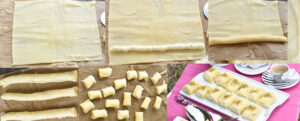

If you make the " Halawet Al Jibn ", leave a comment below, or share your pictures on Facebook! I would love to see your creations!! Hashtag, #Hadia’s lebanese Cuisine

Halawet Al Riz is a sweet cheesy rice pudding worth learning about!
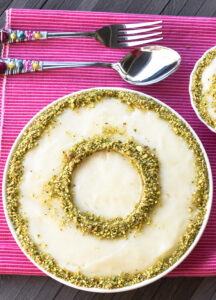
Subscribe to Our Newsletter
Instructions
No Steps Found !
- Recipe Type : BreakFast, DESSERTS, DESSERTS, LEBANESE RECIPES, Lebanese Style Recipes
- Ingredient : Ashta, Cheese, Sugar syrup
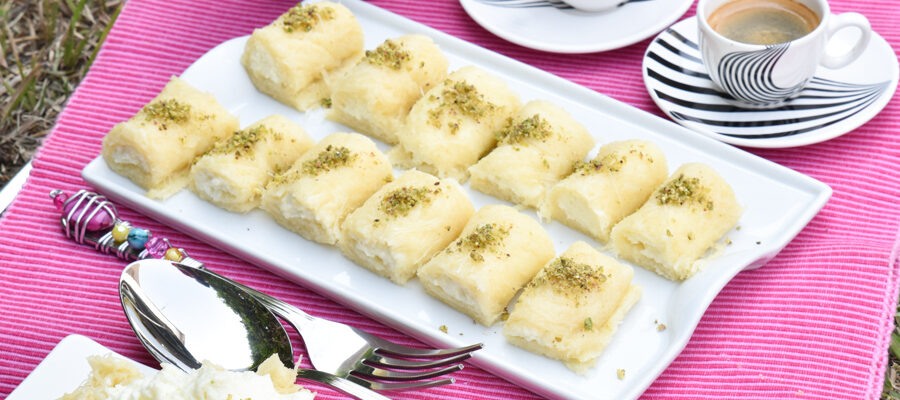
4 Responses to Halawet Al Jibn
Leave a Reply Click here to cancel reply.
About Chef
Hadia Zebib
I am Hadia, the face behind Hadia’s Lebanese Cuisine. I grew up in Beirut Lebanon and I currently reside in Kinshasa, Congo with my husband and my three adorable sons, ...
Read more about this chef..

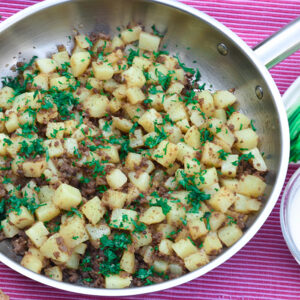

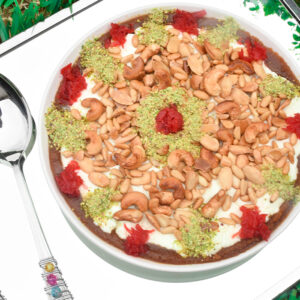



I’m not that much of a internet reader to be honest but your
sites really nice, keep it up! I’ll go ahead and bookmark your site to come back down the road.
Cheers
Thank you, xoxo
Thank you for recipe for Halawet Al Jihn. It calls for 3/4 c fine semolina and 1/4 c. semolina. does this mean coarse semolina? I look forward to making this dessert and would like to get the correct ingredients. Very informative and educational site and photos of recipe is so helpful.
My pleasure, Elaine, yes 1/4 cup coarse semolina. Enjoy!